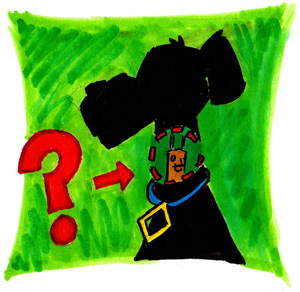Fellow members of the academic community: thank you for attending. I’d just like to start by saying there are fire extinguishers located at both sides of the room.
 Art, they say, is subjective. But that does not shield it from scientific analysis. I have brought you here tonight so I may discuss a great crisis in science. Arts and entertainment have violated the prior respect of accuracy and logic in a basic tenet of sciences: biology. We face a crisis, ladies and gentlemen. One that has built up over the last few decades and unless we address it I feel it will only get worse.
Art, they say, is subjective. But that does not shield it from scientific analysis. I have brought you here tonight so I may discuss a great crisis in science. Arts and entertainment have violated the prior respect of accuracy and logic in a basic tenet of sciences: biology. We face a crisis, ladies and gentlemen. One that has built up over the last few decades and unless we address it I feel it will only get worse.
My report, “Comparative Mental and Cognitive Assessments In Relation To Documented Biological Anomalies in Canine Species,” means to address this very crisis. For guests of the doctoral community here tonight: I am referring, of course, to how talking dogs make no sense.
Now, certainly I don’t wish to imply that a talking dog itself makes no sense. No no no–what I mean is that a talking dog, or any of the various forms of hyper-intellectual dogs, defy logic in context of any of their counterparts. In the subjective theory of a dog that is biologically advanced to a level of human interaction, those principles have no rhyme or reason.
To understand the problem, let’s example the branching of various forms of wonder dogs across an evolutionary spectrum.
Your first group is, succinctly, talking dogs. We refer here to a canine species that has acquired an advanced, human level mutation, allowing both the higher mental reasoning functions as well as vocal and auditory systems of a human being. Strangely, it appears that the world of animation does the best job of correctly speculating these evolutionary changes, as it is quite logical that a dog capable of human cognition would also prefer a bipedal stance.
Our second group is the basic hyper-intelligent canine. Your Lassie; your Rin Tin Tin; your Turner or Hooch, whichever one the dog is. We must assume that these dogs don’t just possess a superior brain capacity, but also highly developed auditory functions, as they can both hear and process human language. However, they lack the ability to speak the human tongue. This is where the logic becomes troubling.
Wouldn’t ability to understand and process human intellect inherently suggest the ability to speak? Would this breathtaking genetic improvement be coupled with the other advances in such a evolutionary elevation? Are we to believe dogs speaking human is a separate mutation or genetic abnormality of the vocal cords? Have we addressed how the possibility of those being two independent but wholly fantastic mutations is so statistically improbable that it borders on the absurd?
This culminates in the most disturbing of the classifications. The third group. These are the dogs that possess human level intellect, physical ability to speak, but are not interpreted by humans. For reasons that science and biology cannot fathom, these dogs can speak perfect human English but no one can actually hear them. This group is so unique that in my research I have identified only three subjects:
- Wishbone, who enjoys whimsical fantasy adventures throughout the world of children’s literature and can only be heard talking in his own mind and the viewpoint of television viewers,
- Snoopy, whose inability to speak requires his audience to observe repeated moments of mental soliloquy, and
- Mr. Sniffles, a small Chihuahua/Terrier mix who speaks only directly to me when he orders me to set things on fire.
Of course, we’ll address the most disturbing of those three: Wishbone.
Wishbone cannot actually speak, but thinks he can. While Snoopy fantasizes about actions he is doing, Wishbone fantasizes about talking. He not only has the advanced capability of human thought process, but desires communication. And to wear people clothes.
This is key, ladies and gentlemen, for there are numerous questions that linger in this process. Does human brain level implicitly suggest higher intellect? Do these dogs aspire for more than just dog want? How better can we understand what they want, when they are capable of telling us their desires? Who made you the judge of the moral and those damned to cleansing by fire, Sniffles? WHO?
I propose today that we allocate the appropriate funding with both the arts and scientific community to properly bridge the woeful gap in study of intelligent dog communication function. With additional study we can understand what they understand. Identify their needs. Assess fashion tips.
These bizarre insults to nature have a voice, ladies and gentlemen. Whether you hear it or not.
Thank you, and please run, as Mr. Sniffles has identified all in the room who must be purified by the flame, and it is not looking good for the front row.
